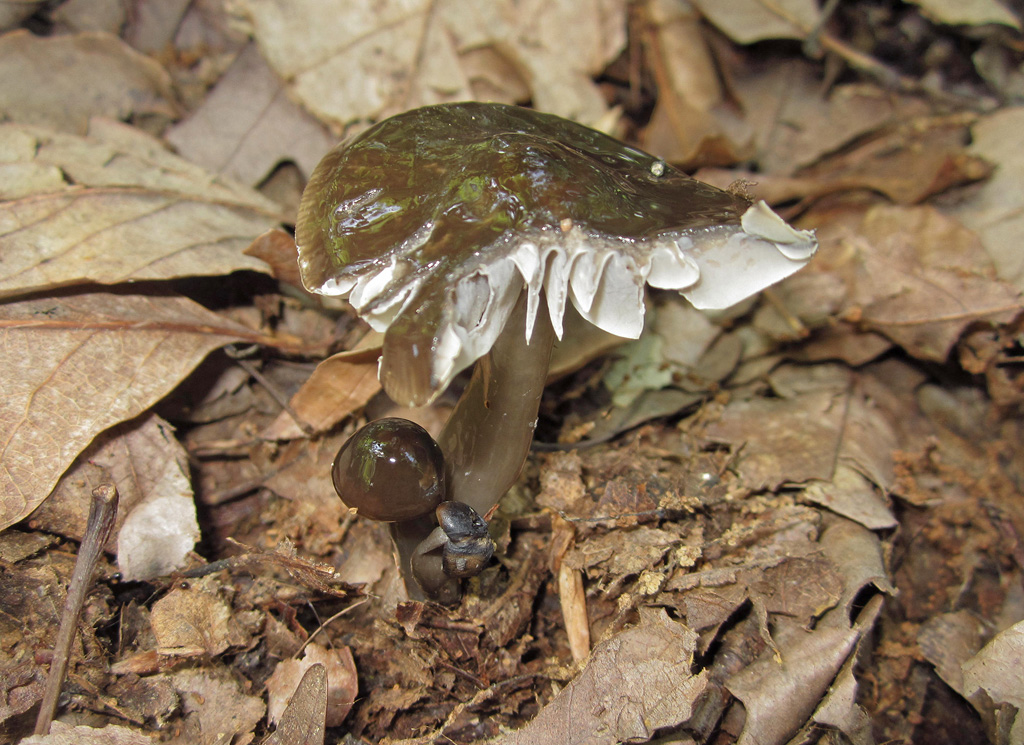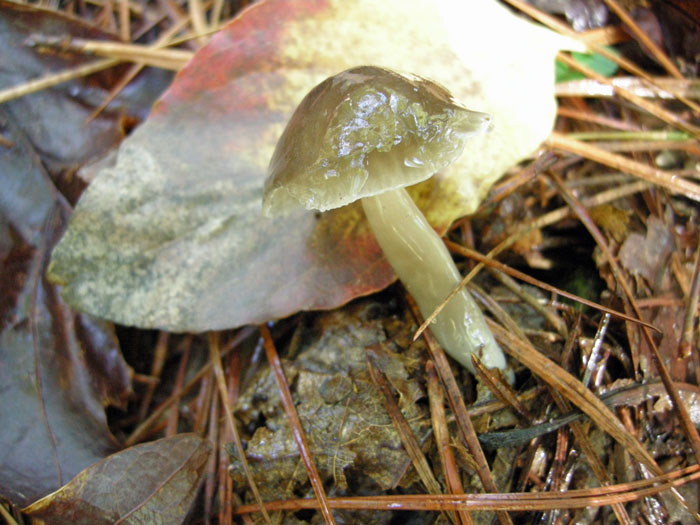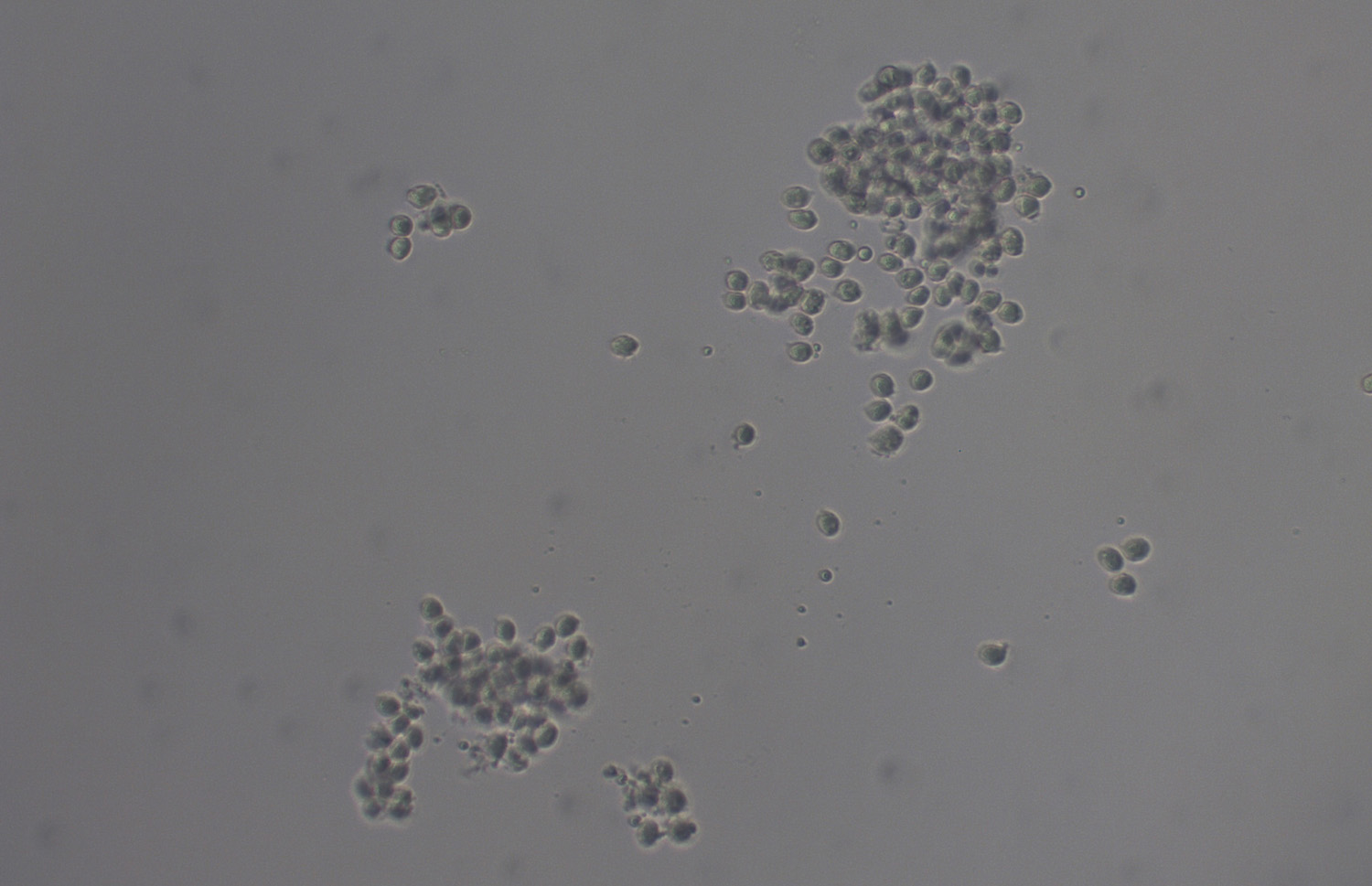Map Snapshot



6 Records
Description
Distinguished by slimy, dark brownish-black color. According to Bessette, the name irrigata means "of wet places." Might be rare in Maryland, although it is widely distributed and is likely overlooked. (L. Biechele, pers. comm.)
Seasonality Snapshot
Source: Wikipedia
| Gliophorus irrigatus | |
|---|---|

| |
| Scientific classification | |
| Domain: | Eukaryota |
| Kingdom: | Fungi |
| Division: | Basidiomycota |
| Class: | Agaricomycetes |
| Order: | Agaricales |
| Family: | Hygrophoraceae |
| Genus: | Gliophorus |
| Species: | G. irrigatus
|
| Binomial name | |
| Gliophorus irrigatus (Pers.) A.M. Ainsw. & P.M. Kirk (2013)
| |
| Synonyms[1] | |
Gliophorus irrigatus is a species of agaric (gilled mushroom) in the family Hygrophoraceae. It has been given the recommended English name of slimy waxcap in the UK.[2] The species is widespread in temperate regions, occurring in grassland in Europe and in woodland in North America and elsewhere.
Taxonomy
[edit]The species was first described in 1801 by the South African-born mycologist Christiaan Hendrik Persoon as Agaricus irrigatus. It was subsequently combined in a number of different genera, before being transferred to Hygrocybe in 1976. The specific epithet comes from Latin "irrigatus" (= watered or bedewed), with reference to the viscid coating of the fruit bodies.[3]
Molecular research published in 2011, based on cladistic analysis of DNA sequences, showed that Hygrocybe irrigata did not belong in Hygrocybe sensu stricto and it was moved to the genus Gliophorus in 2013.[1][4]
Description
[edit]Basidiocarps are agaricoid, up to 100 mm (4 in) tall, the cap convex at first and remaining convex or becoming flat when expanded, up to 50 mm (2 in) across. The cap surface is very viscid when damp, striate at the margin, and pale greyish brown. The lamellae (gills) are whitish to pale cap-coloured and more or less decurrent (widely attached to and running down the stipe). The stipe (stem) is very viscid when damp, smooth, cylindrical or compressed, and grey to cap-coloured. The spore print is white, the spores (under a microscope) smooth, inamyloid, ellipsoid, about 6.5 to 8.0 by 4.5 to 5.0 μm.[5]
Distribution and habitat
[edit]The slimy waxcap has been recorded in Europe, Central and North America, northern Asia, and Australia.[6] Like other waxcaps, it grows in old, unimproved, short-sward grassland (pastures and lawns) in Europe, but in woodland elsewhere. Recent research suggests waxcaps are neither mycorrhizal nor saprotrophic but may be associated with mosses.[7]
Conservation
[edit]In Europe, Gliophorus irrigatus is typical of waxcap grasslands, a declining habitat due to changing agricultural practices. The slimy waxcap is one of the commoner species, however, only appearing on the red lists of threatened fungi in a few countries, including the Czech Republic,[8] Germany (Bavaria),[9] and Poland.[10]
References
[edit]- ^ a b "Hygrocybe irrigata". MycoBank. International Mycological Association. Retrieved 2012-01-12.
- ^ "Recommended English Names for Fungi in the UK" (PDF). British Mycological Society. Archived from the original (PDF) on 2011-07-16. Retrieved 2012-01-12.
- ^ Rea C. (1922). British Basidiomycetaceae: A Handbook of the Larger British Fungi. Cambridge, UK: Cambridge University Press. p. 799.
- ^ Babos M, Halász K, Zagyva T, Zöld-Balogh Á, Szegő D, Bratek Z (2011). "Preliminary notes on dual relevance of ITS sequences and pigments in Hygrocybe taxonomy". Persoonia. 26: 99–107. doi:10.3767/003158511X578349. PMC 3160800. PMID 22025807.
- ^ Boertmann D. (2010). The genus Hygrocybe (2nd ed.). Copenhagen: Danish Mycological Society. p. 200. ISBN 978-87-983581-7-6.
- ^ "Global Biodiversity Information Facility: Hygrocybe irrigata". Global Biodiversity Information Facility. Archived from the original on 2016-03-04. Retrieved 2012-01-12.
- ^ Seitzman BH, Ouimette A, Mixon RL, Hobbie EA, Hibbett DS (2011). "Conservation of biotrophy in Hygrophoraceae inferred from combined stable isotope and phylogenetic analyses". Mycologia. 103 (2): 280–290. doi:10.3852/10-195. PMID 21139028. S2CID 318326.
- ^ "Red list of fungi (macromycetes) of the Czech Republic". Czech Scientific Society for Mycology. Archived from the original on 2011-12-28. Retrieved 2012-01-12.
- ^ "Rote Liste gefährdeter Großpilze Bayerns" (PDF). Bayerisches Landesamt für Umwelt. Archived from the original (PDF) on 2019-08-24. Retrieved 2012-01-12.
- ^ "Czerwona Lista grzybów Polski". Archived from the original on 2012-04-25. Retrieved 2012-01-12.





